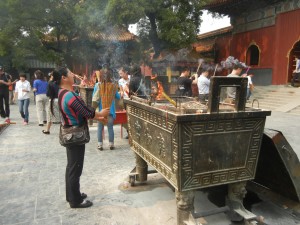Here’s a different world than Gothic Style’s linear order of one god, one savior, one final resurrection.
I took the 2 photos in this post in Beijing’s main Tibetan temple. Of the many traditional temples I visited in Beijing, the Lama Temple was by far the most crowded. Most visitors were young. Maybe a Height-Ashbury thing–young folks attracted to the exotic, in search of meanings beyond conventions. But this is China–conventions are very ancient and deep, and they keep surfacing, even in places where people question them.
The good people in the above photo are throwing coins at a sculpture. If one sticks at the top level, folks get their wish. I tried it a few times, and the one that made it bounced back. Is there something hidden on top that blocks the coins, so that people will toss more in? The possibility didn’t deter the others from continuing to try their luck.
I saw the above scene over and over in the Tibetan temple, and in other temples all over Beijing. People buy a fat bundle of incense sticks. The temple has several altars in each of the 4 cardinal directions. Folks stand in front of each altar, raise the sticks, face each direction, and place three or a few in each altar.
Instead of focusing on one god, as Christianity and Gothic architecture insist on, people hedge their bets by respecting many. And in traditional Chinese religion, there’s a huge number of deities.
Of course people in medieval Europe worshipped lots of saints, and the Catholic church retained this practice, but the architecture of Gothic churches is very linear, and focused on one god and one savior. Chinese temples are more oriented to the 4 directions, and each has deities.
Both Confucianism and Daoism stress harmony within the world, rather than one god who stands so far above the world that he orders all things. He delegates–gods, spirits and people work together to maintain the universe. This ancient view of the world still lives in modern China.



Comments on this entry are closed.